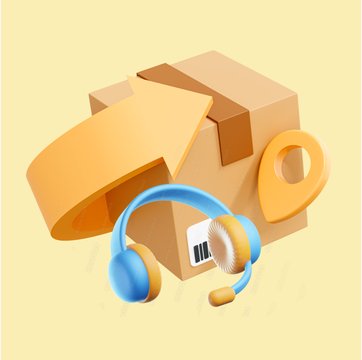Customer Service in Freight Forwarding: A Complete Guide

Table of contents
Experiencing market instability is quite common in the logistics industry. Imagine a scenario where a shipment gets delayed due to unforeseen circumstances. Despite your best efforts, this might still lead to customer dissatisfaction.
But let’s suppose you proactively inform the customer about the delay, explain the situation, and assure them of the delivery, possibly with another tentative date. This approach can keep your customers informed, and chances are that they’d even appreciate the fact that you reached out to them and communicated the delay in advance.
That’s what you call great customer service in freight forwarding.
But why is it important? That’s because it’s no longer a nice-to-have; it’s a necessity. Great customer service in the freight forwarding industry builds trust and ensures that first-time customers become repeat customers.
In this article, we will delve into the strategies to enhance customer service in freight forwarding, ensuring client satisfaction and business growth.
Table of Contents
- What is Freight Forwarding?
- 6 Strategies to Improve Customer Service in Freight Forwarding
- Strategy 1: Understanding Customer Expectations in Freight Forwarding
- Strategy 2: Communication is Key
- Strategy 3: Handling Customer Queries and Complaints Proactively
- Strategy 4: Training and Educating Your Team
- Strategy 5: Building Long-term Relationships By Going An Extra Mile
- Strategy 6: Measuring Customer Satisfaction
- The Bottom Line
What is Freight Forwarding?
Freight forwarding is a service within the global trade and logistics ecosystem. It involves the coordination and shipment of goods from one place to another on behalf of shippers. Freight forwarders act as intermediaries between the shipper and transportation service providers. They are responsible for easing the complexity of dealing with various carriers and understanding myriad shipping regulations.
The service offered by freight forwarders is indispensable, especially for businesses engaging in international trade. They navigate through the maze of documentation, shipping regulations, and carrier negotiations, ensuring timely and cost-effective delivery of goods. This, in turn, allows businesses to focus on their core operations, trusting that their logistics services are in capable hands.
6 Strategies to Improve Customer Service in Freight Forwarding
Here are six actionable strategies that can significantly enhance customer interactions, foster strong partnerships with carriers, and drive overall service excellence in your freight forwarding operations.
Strategy 1: Understanding Customer Expectations in Freight Forwarding
Delivering exceptional service in freight forwarding begins with understanding customer expectations and needs. Here are some of the customer expectations that every logistics business should be aware of:
1. Timely Deliveries
Customers expect estimated delivery time to be provided by freight forwarding service providers. Also, if you partner with other businesses, they even plan their company operations around the scheduled delivery time.
For instance, a retail business can have a promotional event for which it requires certain goods. And therefore, they may heavily depend on logistics providers to communicate the expected delivery date of these goods. Any delay in the delivery could result in cancellation/postponement of the retailer’s promotional event and even financial loss.
Timely deliveries showcase a freight forwarder’s commitment to maintaining schedules and honoring deadlines. This, in turn, builds trust and reliability with customers.
2. Real-Time Tracking with Accurate Information
Real-time tracking provides customers with a sense of control and assurance as they can monitor the progress of their shipments. It is also essential to provide customers with accurate information in the tracking details.
For example, let’s say a family is relocating to a different city. They require real-time tracking to monitor the transit of their household belongings. Any miscommunication or glitch in the tracking system can cause significant delays in the delivery. This could disrupt their moving-in schedule, leading to additional costs and inconvenience.
Transparency through real-time tracking reflects a freight forwarder’s reliability. It also allows for better planning and coordination on the part of the customers.
3. Safe Handling of Goods
Ensuring safe handling of goods reflects a freight forwarder’s commitment to delivering value and maintaining the integrity of the shipped items.
For example, a business client dealing with fragile items relies heavily on the safe handling of their goods during transit. Any damage incurred due to mishandling can lead to claims, dissatisfaction, and loss of business.
Safe handling is particularly important while transporting fragile, perishable, or high-value goods.
4. Easy Issue Resolution
No one likes complicated ways to resolve an issue. A streamlined process for addressing and resolving issues reflects a customer-centric approach.
For example, If an international shipment gets delayed or lost, how swiftly and effectively the issue is resolved by the freight forwarder is critical. Quick resolutions reflect a company’s commitment to customer satisfaction.
Recommended read: Here’s how a logistics company reduced its resolution time by 40%
5. Customized Services
Customized services show a freight broker’s willingness to adapt to the unique needs of different customers. This demonstrates a customer-first approach.
Different customers have different needs. For instance, a customer transporting perishable goods may require quick transit times and temperature-controlled transportation. Thus, offering tailored solutions based on individual customer needs is paramount.
Tips on how to gather insights into customer expectations
Gathering feedback to understand customer expectations can help enhance the quality of freight forwarding service. Here are some tips on how to effectively collect feedback and insights:
- Circulate customer surveys and questionnaires: Creating surveys or questionnaires with specific questions can help gauge customer satisfaction. It can also help gather insights into customer expectations. You can use online survey tools like SurveyMonkey, Google Forms, Typeform, or even simple email surveys to reach out to customers post-service – via various channels – to gather their feedback.
- Conduct Regular Follow-Up Calls: Post-service follow-up calls can provide an opportunity to ask customers about their experience and any suggestions they might have. Direct conversations often elicit more detailed feedback and allow for clarifications.
- Utilize Technology: Invest in tools like CRMs and help desk software to track customer interactions and gather feedback. Utilize analytics to analyze customer feedback data over time and identify trends.
- Competitor Analysis: Understand what competitors are doing well from a customer service standpoint. Analyze their reviews on third-party sites. Learning from competitors can also provide insights into customer expectations in the freight forwarding industry.
Strategy 2: Communication is Key
In freight forwarding, the journey of goods from one point to another involves numerous stakeholders. Any miscommunication or lack of communication can result in delays, increased costs, and unsatisfied customers.
- Importance of Clear Communication: Clear communication means providing accurate and unambiguous information to customers. For instance, if there is a change in the delivery schedule, informing the customer with the exact details of the change and how it affects their shipment is crucial. It eliminates confusion and sets the right expectations.
- Importance of Timely Communication: Timely updates on shipment status, delays, or changes in delivery schedules are vital to keep the customers informed and prepared. For example, if a shipment is delayed due to weather conditions, timely communication allows the customer to make necessary adjustments on their end, minimizing inconvenience.
Tips to improve communication with your customers
Enhancing the avenues of communication is pivotal for ensuring seamless interactions. Here are some strategies to refine communication channels:
- Implement Advanced Technology: Utilize technology like automated notification systems in mobile apps or online portals. It can significantly enhance communication by providing real-time updates and easy visibility of shipment information.
- Have a Customer Service Team: Having a team of dedicated customer service representatives ensures that there’s always someone available to address your customers’ queries and provide updates.
- Invest in Training Your Staff: Training staff on effective communication skills like active listening, clarity in expression, empathy, and timely response are essential. Training should emphasize the use of jargon-free, simple, and direct language to convey information clearly and promptly.
- Invest in a Help Desk Solution: A help desk solution can centralize information ensuring that all support providers have access to the same data. This reduces the chances of miscommunication.
See how a Gmail-based help desk can centralize all your customer communication
Strategy 3: Handling Customer Queries and Complaints Proactively
It is pretty inevitable for customers to reach out to you for queries related to bill of lading, freight shipping updates, cargo insurance, modes of transportation, freight charges, and more. Addressing queries and grievances effectively and learning from feedback is important in providing customer service in freight forwarding. Here’s how to do it:
1. Listen Actively
Active listening is fundamental in understanding the crux of the customer’s issue. This is the first step towards finding a resolution. It’s about giving the customer your full attention, showing empathy, and ensuring that they feel heard and understood. This approach paves the way for a more accurate and satisfactory resolution of the issue at hand.
For example, if a customer complains about a delayed shipment, instead of immediately responding, listen to their entire concern. Ask questions like, “Can you tell me more about how this delay has affected your operations?” to understand the impact better. Once you have a complete understanding, then respond with potential solutions or the steps you’ll take to address the issue.
2. Acknowledge and Apologize
Acknowledging the issue is the next step. It shows the customer that you are aware of the situation and are taking their concern seriously. It is equally important to apologize for the inconvenience caused. It demonstrates professionalism and empathy. It also helps in diffusing negative emotions the customer might have, creating a more favorable ground for finding a resolution.
For instance, if a shipment gets delayed due to unforeseen circumstances, proactive acknowledgment can go a long way. A simple statement like, “We apologize for the delay in your shipment and understand the inconvenience caused,” shows that you value the customer’s experience and are keen on rectifying the situation.
Recommended read: How to Deal With Difficult and Angry Customers
3. Offer Solutions
Providing realistic solutions or alternatives demonstrates a proactive approach to addressing the customer’s concerns. It’s essential to offer solutions that are achievable and beneficial to the customer. It creates a positive impression despite the initial issue.
For example, if a shipment is delayed, offer a clear update on the new expected delivery time. In extreme cases, compensatory solutions like a discount on future services can help mitigate the situation.
4. Maintain a Positive Tone
Maintaining a courteous and positive tone, even in adverse situations, shows professionalism. It also shows respect towards the customer, which can significantly impact their perception of your business.
For example, it is a good practice to respond to negative online reviews politely and professionally, expressing a willingness to resolve the issues. This showcases a constructive approach.
5. Act Promptly
While acknowledging the issue and apologizing for it are fundamental steps you take to handle customers tactfully, the most important part of the process is ‘action’. Prompt action in addressing complaints signifies that you value the customer’s time and concern. It also helps in resolving issues before they escalate, improving the overall customer experience.
For example, if you receive a complaint about a missing shipment, initiate an immediate investigation. Also, keep the customer informed at each step. This shows a sense of urgency and commitment to resolve the issue.
6. Follow-Up
Following up after resolving an issue reaffirms to the customer that you value their satisfaction. It also provides an opportunity to ensure that the solution meets their expectations, fostering goodwill.
You can schedule a follow-up call or email to check if the resolution met the customer’s expectations. You can also inquire if there’s anything more you can do.
7. Encourage Feedback
Encouraging customers to provide feedback creates an open channel of communication. It allows you to gather valuable insights into your service quality.
Implementing post-service surveys or providing feedback forms on your website or after resolving a query can make it easy for customers to share their experiences and suggestions.
8. Learn and Improve
Continuous improvement is key to evolving customer service quality. Analyze feedback to identify recurring issues or areas of improvement. This helps in enhancing service delivery over time.
For example, if feedback from multiple customers indicates a problem with tracking shipments, invest in a more reliable tracking system like Ship Track, CargoWise, Track-POD – to name a few.
Recommended read: 8 Examples of Bad Customer Service and How to Avoid Them
Strategy 4: Training and Educating Your Team
A well-trained team is the bedrock of outstanding customer service in any freight forwarding company. Here’s why training your customer service team is essential:
- Efficiency and Satisfaction: A proficient team, well-versed in freight forwarding operations, can swiftly and accurately resolve customer inquiries. For instance, being able to provide immediate updates on a shipment’s status or addressing customs clearance-related queries enhances customer satisfaction and trust.
- Professionalism in Crisis: Trained personnel can navigate through unforeseen challenges or complaints in a professional manner. This is crucial in the freight forwarding business, where unpredictable situations like customs delays or transport disruptions are common.
- Adaptability: Continuous training equips your team to smoothly adapt to industry shifts ensuring a consistent quality of service. For instance, in freight forwarding, regulations may change as shipments cross borders. And a well-trained support team can swiftly adapt to new customs procedures, ensuring the timely movement of goods.
- Enhancing Business Reputation: Exceptional customer service, driven by a well-trained team, bolsters your business reputation in the competitive freight forwarding market. For instance, a team adept in managing cross-border shipments with diligence and professionalism reflects positively on your business reputation. This encourages customer loyalty and recommendations in the long run.
How to Train Agents to Improve Customer Service Skills?
Training is an ongoing process. Here are some suggestions on how to equip your team with essential customer service skills:
- Regular Training Programs: Conduct training sessions on industry standards, company policies, and customer service best practices in the freight forwarding domain. You can also schedule monthly training on handling customer complaints about shipment delays and improving communication skills to provide timely updates.
- Onboarding Training: Initiate a comprehensive onboarding process to acquaint new hires with common queries received in freight forwarding. Also, educate them on the expected level of customer service for addressing issues like customs clearance or transportation arrangements in freight services.
- Online Courses: Encourage team members to enroll in online courses focused on customer service and communication within the logistics sector. This could be part of their Learning and Development (L&D) benefits, enhancing their understanding of freight forwarding operations and customer interactions. A few well known courses include:
- Supply Chain Fundamentals: Customer Service Operations– This course aims to make learners more effective in entry-level or supervisory roles in customer service and order management, specifically within the context of a supply chain.
- Fundamentals of Logistics, Supply Chain & Customer Service– Offered on Udemy, this course is divided into three parts covering Logistics, Supply Chain, and Customer Service. It starts with fundamental concepts of logistics and supply chain management, helping learners understand how logistics work and the critical skills needed to be successful in this field.
- Workshops: Organize workshops with industry experts to delve into insights and advanced knowledge on global trade regulations. For instance, a workshop on “How to Communicate Customs Regulations or Shipping Processes to Customers” can empower your support team to handle customer queries more effectively.
- Role-Playing Exercises: Engage in role-playing exercises to simulate various customer service situations common in freight forwarding, like handling negative feedback regarding shipment handling. This can equip agents to manage such scenarios better in real-world settings.
- Feedback and Performance Reviews: Offer feedback on interactions your agents have with customers. Conduct regular performance reviews to pinpoint areas for improvement in handling shipment tracking inquiries or complaints.
- Resource Library: Assemble a library of resources or a comprehensive guide covering essential freight forwarding procedures, customer service protocols, and common issues for your team to reference and learn from. For instance, a resource library can include standardized responses for common queries. When a customer calls about a customs clearance delay, the representative quickly accesses the library, provides a standardized response about the clearance in the logistics process, and follows the outlined escalation procedure to address the customer’s concern swiftly.
- Peer Learning: Cultivate a culture of peer learning for shared experiences and collective growth within the freight forwarding environment. Organize regular team meetings to share experiences in handling complex shipping scenarios and discuss challenges faced in customer communication. This fosters a collaborative learning atmosphere.
Recommended read: 10 Brilliant Customer Service Training Games
Strategy 5: Building Long-term Relationships By Going An Extra Mile
Nurturing lasting relationships with customers is the hallmark of a successful freight forwarding business. Here’s a deep dive into the strategies to make this happen:
1. Consistent Service Quality
Consistency in service quality drives customer trust. When customers know what to expect and those expectations are met or exceeded every time, trust is strengthened. This consistency includes timely deliveries, accurate tracking, and proper handling of goods.
Make a point to ensure that every shipment reaches its destination on time and in good condition. This will build a reputation for reliability, encouraging customers to continue using your services.
2. Personalized Interactions
Personalization goes beyond addressing a customer by their name. It extends to understanding their shipping needs, preferences, and past interactions. Personalized services make customers feel valued and understood, paving the way for a long-term relationship.
For instance, if one of your customers frequently ships fragile items, suggest additional padding or insurance options. This shows your attentiveness to their unique needs.
3. Loyalty Programs
Loyalty programs reward customers for their continued business with you. This makes them feel appreciated and incentivized to maintain the business relationship. These programs can include discounts, rewards points, or exclusive offers for loyal customers.
For instance, you can set up a loyalty program where customers earn points for every shipment, which can be redeemed for discounts on future services. Programs like these can cultivate long-term loyalty.
4. Adding Value
Offering value-added services or information can enhance customer satisfaction. It fosters a deeper connection between you and your customers. This could include educational content, advisories, or complimentary services.
You can share monthly newsletters with updates on international shipping regulations and tips. These can add value to your customers’ experience.
5. Celebrating Milestones
Celebrating significant milestones in the customer’s journey creates a sense of partnership. It shows that you value their success and association.
For example, you can send a congratulatory message or a small token of appreciation on a customer’s business anniversary.
6. Availability
Ensuring that customers can easily reach you when they need assistance is important. It builds confidence and a sense of reliability.
Make sure to have a dedicated support team to cater to your customer queries. You can also invest in help desk software that creates a repository of your communication with your customers. This way, you will get to have contextual communication every time a customer reaches you.
7. Transparency
Being transparent about pricing, services, and terms creates a clear understanding for your customers. It also sets the right expectations, which is fundamental for building trust.
For example, it is important to provide a detailed and clear commercial invoice with no hidden charges. This ensures that customers know exactly what they are paying for.
Recommended read: A Complete Guide to Customer Relations
Strategy 6: Measuring Customer Satisfaction
Understanding customer satisfaction is crucial for any business. The same stands true for freight forwarding as well. Here are various metrics to gauge and enhance customer satisfaction:
1. Customer Satisfaction Score (CSAT):
CSAT is a metric that captures how satisfied your customers are with your products or services.
CSAT (Customer Satisfaction Score) is a metric used to gauge the satisfaction of customers with your product or service.
It’s typically measured using a single-question survey, asking customers to rate their satisfaction on a scale, often from 1 to 5 or 1 to 10, with a higher number indicating greater satisfaction.
The CSAT score is then calculated as the average rating or the percentage of positive responses. This provides a quick snapshot of customer satisfaction at a given point in time.
2. Net Promoter Score (NPS)
Net Promoter Score (NPS) is a metric used to assess customer satisfaction and loyalty by asking customers a single question: “On a scale of 0 to 10, how likely are you to recommend our company to a friend or colleague?” with the higher number indicating that they are more likely to recommend.
A customer’s response is categorized into three groups:
- Promoters (score of 9-10): Highly satisfied customers who are likely to recommend the company.
- Passives (score of 7-8): Satisfied but unenthusiastic customers who might switch to competitors.
- Detractors (score of 0-6): Dissatisfied customers who are unlikely to recommend the company.
Then, the final NPS is calculated using the formula: - NPS=(Percentage of Promoters−Percentage of Detractors)×100
You can conduct a bi-annual NPS survey and compare the scores over time to track changes in customer loyalty.
3. Customer Effort Score (CES)
Customer Effort Score (CES) is a metric used to measure the ease with which customers can achieve their goals when interacting with a company. It aims to gauge the effort required on the customer’s part to get an issue resolved, a request fulfilled, or a product or service accessed.
Here’s how it’s typically done:
- Survey Question: Customers are asked to rate their experience with a statement like, “The company made it easy for me to handle my issue,” on a scale, often ranging from 1 (Strongly Disagree) to 7 (Strongly Agree).
- Calculation: The scores are then averaged to calculate the CES, with a higher score indicating a more effortless customer experience.
- Interpretation: A higher CES indicates that customers found it easy to interact with the company, suggesting a better customer experience. Conversely, a lower CES might indicate potential areas for improvement in reducing customer effort.
A Detailed Guide to Customer Satisfaction Surveys
4. Analyzing Customer Interactions
Reviewing interactions through emails, calls, or chat support can provide insights into common issues, customer concerns, and the overall quality of service interaction.
You can do a monthly analysis of customer service emails to identify recurring issues or areas for improvement in communication.
5. Customer Retention Rate
Customer Retention Rate (CRR) is a metric used to measure the percentage of customers a business retains over a specific period of time. This metric showcases the business’s ability to maintain long-term relationships with its customers.
Formula:
CRR=[(Number of customers at the end of the period−Number of customers acquired during the period)/Number of customers at the start of the period] × 100
where,
The number of customers at the start of the period implies the initial customer count at the beginning of the measurement period.
Number of customers acquired during the period implies new customers acquired over the measurement period.
Number of customers at the end of the period implies The total customer count at the end of the measurement period.
By substituting these values into the formula, you calculate the Customer Retention Rate in percentage. A higher CRR indicates better customer retention. It also implies higher customer satisfaction, as satisfied customers are more likely to continue doing business with the company. This metric is crucial for businesses to monitor, as retaining existing customers is often more cost-effective than acquiring new ones.
The Bottom Line
The logistics industry evolves over time, and so understanding your customer needs is the key to the right customer service. This can be achieved by a proficient support team and a robust help desk solution that can streamline customer communication.
Speaking of help desk platforms, you might want to check out Hiver. It streamlines customer interactions, ensuring timely and efficient communication. It also helps your support team to collaborate on customer queries in order to resolve them faster. The best part is you can do all these right from your Gmail inbox!
Interesting? Schedule a free demo to know more!

































